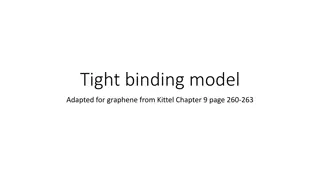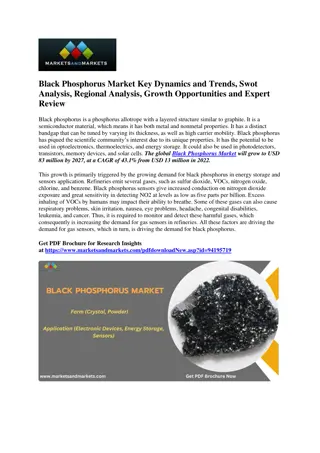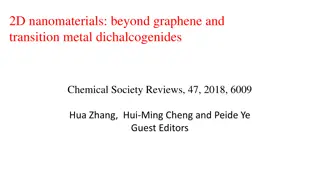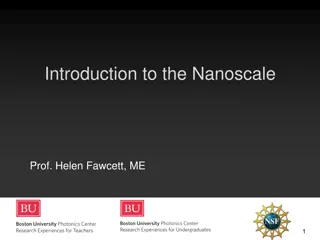Exploring the Fascinating World of Graphene
Graphene is a revolutionary crystalline allotrope of carbon with exceptional 2-dimensional properties. Its history, structure, production methods, and applications showcase its remarkable characteristics. From mechanical exfoliation to liquid phase exfoliation, various techniques have been developed for graphene production. Graphene oxide (GO) production has also opened up new possibilities, despite some reduction in properties. The potential of graphene in various fields is vast and continuously evolving.
Download Presentation

Please find below an Image/Link to download the presentation.
The content on the website is provided AS IS for your information and personal use only. It may not be sold, licensed, or shared on other websites without obtaining consent from the author. Download presentation by click this link. If you encounter any issues during the download, it is possible that the publisher has removed the file from their server.
E N D
Presentation Transcript
Short History 1916 Graphite structure using powder diffraction 1948 First TEM images of few-layered graphite (G. Ruess F. Vogt) 1970s Epitaxial growth of single-layered graphite on other materials 1990 Efforts to make thin films of graphite by mechanical exfoliation (50-100 2004) 2004 Extraction of single-atom-thick crystallites from bulk graphite (Andre Geim Kostya Novoselov, The University of Manchester).Use of scotch tape to pull graphene layers from graphite and transfer onto thin SiO2on a silicon (Scotch tape technique)
Structure Crystalline allotrope of carbon with 2-dimensional properties. Densely packed carbon atoms in a regular atomic-scale chicken wire(hexagonal) pattern Each atom has four bonds, one and one -bond. The atoms are about 1.42 ngstr ms apart Graphene's hexagonal lattice can be regarded as two interleaving triangular lattices. This perspective was successfully used to calculate the band structure for a single graphite layer using a tight-binding approximation. Great stability due to tightly packed carbon atoms and a sp2hybridization. The -bonds hybridize to form the -band and -bands. These bands are responsible for most of graphene's notable electronic properties, via the half-filled band that permits free-moving electrons. Graphene sheets in solid form usually show evidence in diffraction for graphite's (002) layering Graphene can self-repair holes in its sheets, when exposed to molecules containing carbon(hydrocarbons). Bombarded with pure carbon atoms, the atoms perfectly align into hexagons
Mechanical exfoliation Confirmation of the existence of graphene as a two- dimensional crystal(A. Geim and K. Novoselov in 2004, Nobel Prize in Physics in 2010). Isolation of graphene sheets by adhesive tape and transfer to the desired substrate Best quality of produced graphene Disadvantageous in the control of shape and quantity.
Liquid phase exfoliation Occurs with the help of solvents and / or surfactants and the imposi- tion of some external force in the process (ultrasonication, blender) Improves the problem of the quantity produced Degrades its properties as it is difficult to remove the solvents and / or surfactants Use of materials, which will not affect the application of the graphene we desire.
Graphene oxide production (GO) Greatly increases the amount produced The oxidized sheets of graphene acquire the dispersion property in many solvents their remaining properties are dramatically reduced The first method for GO production was made by Hummer in 1958 and several others have since been developed.
Epitaxial growth of graphene on silicon carbide (SiC) substrates Takes place under high vacuum and high temperature conditions Si atoms are sublimed and bonds are formed between the carbon atoms Possible to check the number of layers and their size The quality and energy requirements are the main drawbacks
Chemical Vapor Deposition, (CVD) Control of size and quantity is best achieved Degraded quality, however good enough Graphene growth occurs on metallic surfaces (Cu, Ni) High temperature and atmospheric conditions needed Use of mixture of gases, typically 95% Ar, 5% H, carbon rich materials (methane) Formation of bonds between the carbon atoms.
Forms Mono-multilayer sheets Graphene nanoribbons Graphene oxide Graphene ligand/complex Pillared graphene Graphene aerogel
Graphene in suprachem Merge of graphene with porphyrins Change of properties Use in photovoltaics, optoelectronics, and spintronics THPP TCPP
K.S. Novoselov, et al., A roadmap for graphene. Nature, 2012. 490(7419): p. 192-200. A.K. Geim, and K.S. Novoselov, The rise of graphene. Nat Mater, 2007. 6(3): p. 183-191. Kornelia Lewandowska et al., Supramolecular Complexes of Graphene Oxide with Porphyrins: An Interplay between Electronic and Magnetic Properties, Molecules, 2019























